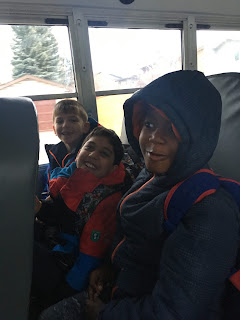Hello!
We had another busy week. As an update, the school raised $1794.46 in our Terry Fox run! Great work! We didn't quite hit the minimum to let us shave off Mr. Hippe's beard, so we'll have to find another way to get rid of that.
In Math, we continued to work on our number sense by looking at our number system of Base 10. We did so by looking at the fact that other systems for counting exist. We watched a brief video on Base 12. We paused about half way through as not to make it too complicated. Take a look if you like: Base 12 video.
The point was to make the children more comfortable with math by showing them that they can play with it, manipulate it, and to get them to understand why we use the system we do (Base 10). Understanding that we have only 10 symbols, what those symbols are, and the pattern we have for using them to create new numbers will also build their general number sense.
You can work with your child at home on building number sense. Try this link: Number Talks. Scroll down to Grade 3/4. Choose a pattern, and show it briefly to your child. Have them try to figure out the number of dots, and then have them explain their strategy to you. This builds subitizing skills (the ability to look at a group of things and "see" the number instead of having to individually count it out).
In Literacy, we are continuing to read to develop our comprehension skills using Reading Powers. Making connections to stories and other texts helps students internalize what they are reading. We are also writing some fiction right now. Have your child tell you about their turkey story! Our grade 3s are continuing to work on their secret project while we develop our grammar skills. Ask your child about verbs, nouns, adjectives.
In Social Studies, we began our journey to Peru. Our passports were completed, checked at the passport office, and we "flew" to Lima. The kids enjoyed the flight with Mrs. Wilson (our team teacher from Room 17) and myself, and are excited to start exploring Peru's food, culture, clothes, and history.
In Science, we began our investigation of ecosystems (plants and animal life cycles) by receiving news that we had been selected by NASA to help design eco-columns for their astronauts as they prepare to make a 5-year journey to the newly discovered planet X-97a.
If you have any 2L pop bottles at home, please send them in, as we'll need them to build our columns. NASA will supply the rest of the materials.
In this investigation, we will learn about plant life cycles by planting a variety of seeds and watching them grow, collecting data about temperature, growth rates, and other things. We'll graph the data, write reports about our findings. We'll study the decomposition of different materials (bananas, kiwi, for example).
I've hired a class cinematographer (one of our students, chosen weekly :)) to document our journey. As soon as we have edited down some of the footage, we'll start posting it here for you to see. My apologies, as we didn't have time to get to it this week.
In Art, we used our artistic thinking and skills in our science project. We had to design cover pages for our eco-column challenge in our visual journals. The children had to select colours and make a wash as a background. They had to write about why they selected those colours, and how they represent the eco-column. We then tore letters from magazines to spell out the letters of our project.
Next, we'll begin designing our columns, thinking like scientists and engineers about use of space, materials, why we are doing what we are doing, and taking the time to create a design that is neatly drawn and replicable.
We have a lot ahead of us. For homework, please read with your child nightly, and have them read to you. Play some math games. Show them something you think is fascinating about the world. Build their curiosity.

















































